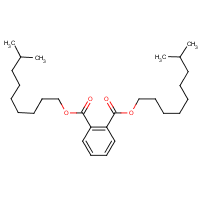Diisodecyl phthalate
Agent Name
Diisodecyl phthalate
Alternative Name
DIDP
CAS Number
26761-40-0
Formula
C28-H46-O4
Major Category
Plastics & Rubber

Synonyms
DIDP; 1,2-Benzenedicarboxylic acid, diisodecyl ester; Bis(isodecyl) phthalate; Bis(isodecyl)phthalate; DIDP (plasticizer); Di(i-decyl) phthalate; DIDP; PX 120; Palatinol Z; Phthalic acid, bis(8-methylnonyl) ester; Phthalic acid, diisodecyl ester; Plasticized DDP; Sicol 184; Vestinol DZ; [ChemIDplus]
Category
Phthalate Esters
Description
Clear liquid; [Hawley] Oily viscous liquid; [CHEMINFO]
Sources/Uses
Used as plasticizer for polyvinyl chloride in calendered film, coated fabrics, building wire jackets, wire and cable extrusion, and other applications; [HSDB]
Comments
An irritant; [Hawley] Oral LD50 (rat) = 64,000 mg/kg; [ChemIDplus] A skin and eye irritant; May cause liver injury; [ICSC] Like dioctyl phthalate, it may cause CNS depression and mild liver toxicity after ingestion of large amounts; [HSDB] A mild skin and eye irritant; "Di-"isodecyl" phthalate is a complex mixture containing mainly C10-branched isomers, with a mean formula, C28-H46-O4 and a mean molecular weight of 446.68. There are two di-"isodecyl" phthalate products (DIDP), with two different CAS Nos. (26761-40-0 and 68515-49-1), which contain a number of components. The main chemical structures or chain structures present in DIDP, include trimethylheptyl, dimethyloctyl, methylnonyl and n-decyl." [CHEMINFO] May cause irritation; [MSDSonline] See "PHTHALATE ESTERS." See "1,2-Benzenedicarboxylic acid, di-C9-11-branched alkyl esters, C10-rich."
Biomedical References
Exposure Assessment
Vapor Pressure
5.28E-07 mm Hg
Lethal Concentration
LC (rat) > 130 mg/m3/6h
NFPA
must be preheated
Adverse Effects
Hepatotoxin
Hepatoxic (a) from occupational exposure (secondary effect) or (b) in animal studies or in humans after ingestion
Diseases, Processes, and Activities Linked to This Agent
Processes
Industrial Processes with risk of exposure: